To maintain and improve the resort community (CID*) and to promote tourism businesses (BID**), the following are done.
1) Services that are not included in ordinary government services but that benefit the public are provided.
2) The funds necessary for such services/projects are collected from every property owner in a transparent, fair manner.
3) An organization to provide the services is established.
4) Ultimately, the CID/BID aims to raise the property values in the area.
The Hirafu area is aiming to introduce the first CID/BID in Japan after establishing relevant town laws.
* A precedent of a CID (Community Improvement District) is in Washington, D.C., USA.
* * The first BID (Business Improvement District) was in Toronto, Canada. (In Canada, it’s called a BIA (Business Improvement Area).) It has been successfully adopted by many North American, UK, Continental European and Australian cities.
■ Hirafu Vision (draft)
Proposed vision (draft): “Niseko Hirafu, a resort you’d love to live in”
- toward a safe, clean and vibrant Hirafu
■ Objectives
a. To maintain a safe and clean Hirafu and to warmly welcome guests while keeping Hirafu vibrant through the mutual efforts businesses, property owners and the like
b. To create a completely new community management system in which residents and absent property owners work together as members of the Hirafu community
c. To increase the revenue of accommodations, restaurants, retailers and other service businesses and thereby to raise property values by conducting projects that increase day and overnight visitors to Hirafu
■ Project envisioned
●CID mission: Enhancing Hirafu as "a wonderful place to live."
- Maintaining street lights (electricity, installation, repair)
- Beautifying the area (installing flower beds/pots along main streets and in the park)
- Supporting community events
●BID mission: Making Hirafu "a superb place to visit."
- Litter/trash pick-up (Trash collection persons assist/guide people on the streets, in addition to picking up tourists' discarded bottles, cans and other street litter.)
- Street banners, illumination
- Promotional media equivalent to the Wine and Dine guide
- Information dissemination and drawing visitors to Hirafu via Web/SNS
- Supporting and promoting local events (restraint fair, Hirafu festival, Hirafu winter festival, etc.)
- Road heating electricity cost of Hirafu-zaka St. (other than borne by the Town Office: 60%, or 3.6 - 4.0 mil. yen)
● Projects that do not
require substantial project costs
Hospitality
improvement
-
Making the resort environment more pleasant
- Making local rules, making people observe them and strengthening local networks of people
Example:
Maintenance/management of real estate in the snow-free season
Cutting back encroaching vegetation at vacant
developed plots
Prohibiting people from discarding bottles,
cans and other litter on the street
Restricting fireworks (bottle rockets, etc.) and noise
Requesting infrastructure
improvements/repairs to governments
Developing a disaster information network
Making group contracts with credit card
companies (to reduce credit service charges)
■ Why do we need a CID/BID?
In Hirafu, investments by overseas businesses and internationalization of the region have resulted in over 80% of properties having absent owners. The chonaikai system that has maintained street lights, the local environment and garbage collection stations has become difficult to maintain because only 15% of property owners are members. Consequently we need to create a completely new system where residents and absent property owners collaborate as members of the Hirafu Community.
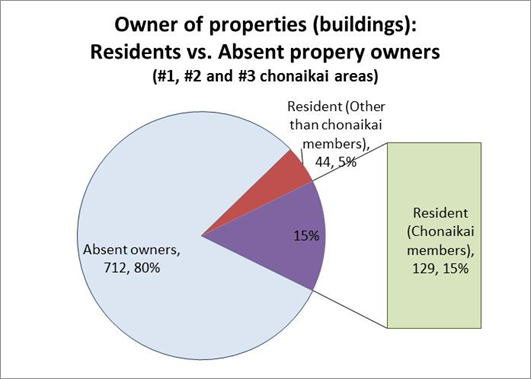
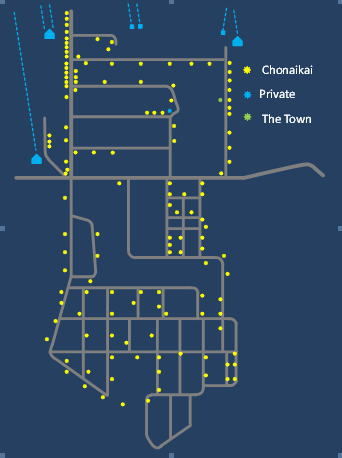
Street lights locations and owners
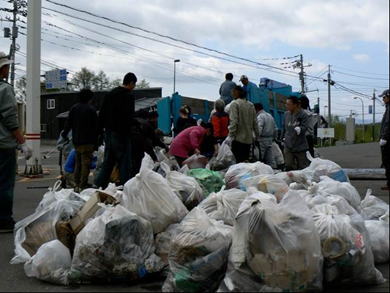
Litter collection by local volunteers in the spring
■ Estimated project budgets
Based on a very rough budget, it will cost approximately 25,000,000 yen to achieve the project budget:
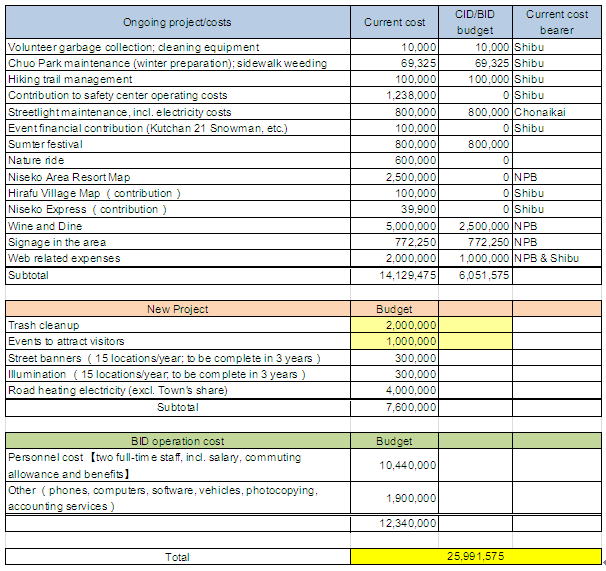
■ Subject
area
a. Chonaikais #1, #2
and #3 will be the CID/BID area.
b. Chonaikai #4 and
Kabayama Chonaikai: Ask the
residents/businesses whether they wish to
join the CID, the BID or both.
c. Businesses in Chonaikai # 4 and Kabayama Chonaikai: Individual businesses
in Chonaikai #4 and Kabayama Chonaikai may join the BID if the entire business
community decides not to join BID.
Because Chonaikai #4 and Kabayama Chonaikai have many
members and are well managed, we're
planning to ask the chairpersons of the chonaikais to discuss with the
chonaikai members about joining the CID.
■
CID/BID fee collection method (draft)
■ CID fee collection principles
1) Every building is
subject to the fee.
2) Garages,
storage huts, etc are not subject to the fee.
3) Each
house or condo unit is counted as one unit in terms of fees.
4) In a building
where the owner lives and operates an accommodation facility, such as a
pension, the fee shall be for one unit
● CID fees
• Plan 1: The residential portion, the accommodation portion or the shop/restaurant/etc. portion of a building is counted as one unit each. For example, a pension that runs a bar is counted as three units.
• Plan 2: A residence that's in the same building as an accommodation or a shop/restaurant, etc. is not counted. The case in Plan 1 would be two units.
• Each condo or apartment unit is counted as one unit.
• Because residents work as volunteers year-round, their CID fees may be half those of absent property owners.
• Definition of a resident: 1) a natural person who registers as a resident of the Town of Kutchan by the cut-off date, or 2) a legal person who has a registered headquarters or branch office in Kutchan by the cut-off date
● Discussion Points:
• Can we make the CID fee of Kutchan registered residents/legal persons 50% that of absent property owners?
■ BID fee collection principles
1) All income-earning
real estate (buildings, land) are subject to BID fees.
2)
Farmers' barns are exempt from the fee.
Factors to be considered: sharing of benefits and costs
1) Road heating
2) Street beautification
of Hirafu-zaka St. and Prefectural Rd. 343
3) The difference in
building height limit, by area (22 m vs. 13 m)
● BID fees
1) Accommodations
• One bedroom is one unit. BID fees for one unit may be from 3,000 to 6,000 yen (to be decided).
• Rooms to be rented to tourists, such as condos, are counted as accommodation facilities.
• The living room of a condo is counted as one unit.
• A loft/attic is counted as half a unit, unless it is separated by walls.
• Definition of an accommodation facility: Those registered with the public health centre as "accommodation facilities." When a facility, room or condo unit is found to operate as an accommodation without being registered with the public health centre, the BID shall assist the owner in making prompt registration with the public health centre so as to resolve the legal irregularity.
• Definition of a long-term contract apartment/room: An apartment/room rented on a contract longer than three months and rented to a Kutchan town resident whose registered address is the site of apartment/room.
• Definition of a second house: The owner is not a resident of Kutchan town and has not rented out the dwelling during the year.
2) Restaurants, bars, retailers, offices, etc.• [30,000~40,000] yen per property + floor area X 100 yen/m2 (assuming service equivalent to “Wine and Dine” be provided by the BID)
• The above floor area includes only spaces that guests normally use and excludes kitchens, toilets, etc.
3) Vacant developed plots• Definition of a vacant developed plot: Land reclamation was done, or there was a building there in the past.
• Vacant developed plots owned by a Hirafu resident are exempt from the fee as long as they’re properly maintained.
• The unit rate has not been decided.
Questions and opinions to date• The vegetation encroaching on roads from some vacant plots at the bottom of the lower village hinders vehicle/pedestrian traffic. Why don't we make a town law to mandate that owners cut back vegetation from such plots to a few meters from the edge of properties fronting on the road and that, if they fail to do so, the Town or the BID cut the vegetation and send a bill to the owner?
4) Garages and storehouses for outdoor activity services such as rafting: Needs to be discussed.• The unit rate has not been decided.
5) Food trucks: Mandatory registration with the BID and payment of a BID fee• Introduce such trucks via the BID web.
• Registration of a contact person with BID will be mandated.
• Good retailers can be invited the following year or for other event opportunities.
• 35,000 yen/food truck/year or so
Questions and opinions to date
• Why don't we ask businesses in downtown Kutchan to pay a BID fee, because they also benefit from ski tourists in Hirafu?
■ Examples of CID/BID fees
• "Pure" resident: Owns a home in Hirafu and is a registered resident of Kutchan
CID fee: 6,000 yen/year
• Pension owner: Owns a building(s), is the resident of such a building and is a registered resident of Kutchan
CID fee: 6,000 yen/year X "number of buildings owned"
BID fees: "number of accommodation rooms" X unit rate
• Restaurant owner: Owns a building or a unit of building to be used as the restaurant and is a registered resident of Kutchan
CID fee: 6,000 yen/year
BID fees: [35,000 - 40,000] yen/year + "floor area" X 100 yen/m2
• Restaurants (tenant)
No CID/BID fees, because the property owner bears the CID/BID fees.
• Hotel (a building(s) owned by a registered resident or a registered legal person in Kutchan, with a single restaurant)
CID fee: 6,000 yen/year
BID fees: "number of accommodation rooms" X unit rate + [35,000 - 40,000] yen/year + "floor area" X 100 yen/m2
• Condos/chalets: The owner is a non-resident; the property does not rent for a fee.
CID fee: 12,000 yen/year
• Commercial use condos/chalets: The owner is a non-resident; the property is rented on a nightly basis.
CID fee: 12,000 yen/year
BID fees: "number of accommodation rooms" X unit rate
• Long-term contract apartments/rooms: The owner is a non-resident; the property is rented to a Hirafu resident with a contract longer than 3 months
CID fee: 12,000 yen/year
BID fees: "number of accommodation rooms - number of rooms being rented under contracts longer than 3 months to a Hirafu resident*" X unit rate
*Hirafu resident: A person who has registered as a resident of said property by the cut-off day
l Discussion points:
• Should a loft be counted as a room?
• Should a living room of a condo or chalet be counted as a room?
• Can we set a higher unit rate for properties along Hirafu-zaka St. and the Prefectural Rd. 343 elsewhere? That's because those properties benefit the most from BID projects and road heating.
• Can we set a higher unit rate for rooms in the area where the building height limit is 22 m? That's because other areas' height limit is 13 m.
• Can we set a higher unit rate only for a building higher than three stories? That's because buildings with less than two stories do not enjoy the height benefit.
• Can we vary the unit rates by the distance from Hirafu-zaka St.?
• Can we not count living rooms of condos/chalets as one room? That's because not every living room of a condo/chalet has furniture for sleeping.
■ Hirafuzaka St. Road Heating System: Draft proposal for sharing electricity cost
Because the Town of Kutchan owns about 40% of the land fronting on Hirafu-zaka St., the committee has been discussing whether to request that the town bear about 40% of the local share of road heating electricity cost (1.5 m width sidewalk portion). The remaining 60% of electricity cost would be borne by the local community. Nothing has been decided on the method of sharing the 60% of electricity cost among locals.
• The Hokkaido Prefectural Government will bear the electricity cost for the entire carriageway and 2.0 m width of sidewalks. Its electricity expenses will be much higher than those of locals. Therefore, we have been discussing about proposing that the government introduce renewable energy power generation systems toward reducing future electricity cost for locals as well as for the Prefectural Government.
Share of road heating electricity cost by the length of land fronting on Hirafu-zaka St.
• Regardless of whether buildings exist, the owners of land that fronts on Hirafu-zaka St. will be asked to bear part of the electricity cost in accordance with the length of that frontage (2130 yen per meter or so; with the recent increases in electricity rates, it could be higher).
• That's because the properties fronting on Hirafu-zaka St. benefit the most from road heating.
• Vacant developed plots (i.e., without buildings) are subject to road-heating electricity cost sharing. That's because plots on Hirafu-zaka St. are prime locations in Hirafu and, for the sake of the local economy, such land should not be left empty.
Questions and opinions to date• Why do people say the properties fronting on Hirafu-zaka St. benefit more from road heating than properties in other areas or not fronting on that street?
• Why is the share of road heating electricity cost for land on Hirafu-zaka St. measured by the length of frontage? Because property that has a relatively short length fronting on Hirafu-zaka St. but a long overall depth still benefits a lot from the road heating.
• How can we ask businesses far from Hirafu-zaka St. and whose guests don't benefit much from the road heating to bear the road heating electricity cost at the same rate as the businesses fronting on the street?
We have run various simulations and arrived at the following plans:
Plan 1: A uniform accommodation room unit rate, and the fee by length of frontage on Hirafu-zaka St.
1) The unit rate of BID fee for an accommodation room is uniform for the entire BID area.
2) A 30% of the road heating electricity cost (1.8 - 2.0 mil. yen) is paid for by BID fees collected from the entire BID.
3) The remaining 30% (1.8 - 2.0 mil. yen) of the road heating electricity cost are borne by the land owners on Hirafu-zaka St. according to the length of their frontage on the street.
Plan 2: Different unit rate for accommodation rooms, restaurants, retailers and offices, depending on the distance from Hirafu-zaka St., the building height limit and any frontage on Prefectural Rd. 343.
Plan 2-A: Three classifications (unit rates decline in the order of 1, 2 and 3): For example, 1: 5,000 yen; 2: 4,250 yen; and 3: 3,500 yen
1) The buildings (and land) on Hirafu-zaka St. in the Chonaikai #1 area
2) The buildings in the area where the height limit is 22 m, except those in Area 1; namely buildings other than on Hirafu-zaka St. in the Chonaikai #1 area and on Prefectural Rd. 343 in the Chonaikai #2 area
3) Buildings in the Chonaikai #2 and #3 areas other than above.
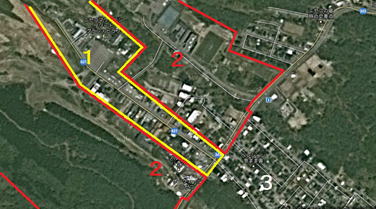
Plan 2-B: Three classifications
(unit rates decline in the order of 1, 2, 3 and 4): For example, 1: 5,000 yen; 2: 4,500 yen; 3: 4,000 yen and 4: 3,500 yen
1)
The buildings (and land) on Hirafu-zaka St. in the Chonaikai #1 area
2)
The buildings not on Hirafu-zaka St. but relatively close to the street
3)
The buildings in areas where the height limit is 22 m, other than 1)
or 2)
4)
Buildings in the Chonaikai #2 and #3 areas other than above
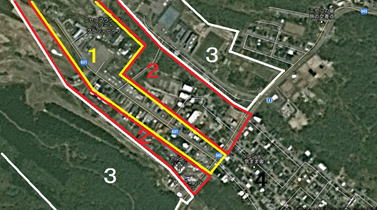
Plan 2-C: Three
classifications (unit rates decline in the order of 1,
2, 3 and 4).
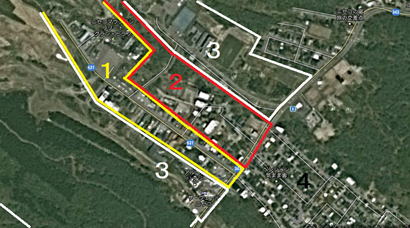
Plan 2 requires discussion/establishment of a fee system for vacant developed plots on Hirafu-zaka St. (the main street).
■ Coordination of roles, activities and fees with other Hirafu organizations (i.e., chonaikais, NPB, Hirafu Shibu and Kutchan Tourism Association.)
• Discussions and coordination have been conducted with relevant organizations to rationalize roles, activities and fees so that the total fees do not increase for CID/BID members.
• The CID proposal includes part of the chonaikai fee (electricity cost and maintenance and repair of street lights) to be collected as part of the CID fee.
■ Japanese Naming of the CID/BID
Although "CID" (Community Improvement District) and "BID" (Business Improvement District) are easy to understand in English, they're difficult to understand in Japanese. We'd like to give them different Japanese names. We welcome your opinions and recommendations.
(Draft proposal) General name: Hirafu Resort Buntankin
CID: Hirafu Resort Community Buntankin Area, Hirafu Community
Improvement District, Hirafu Environment Improvement Area,
etc.
BID: Hirafu Resort Business
Buntankin Area, Hirafu Tourism
Promotion Area, Hirafu Resort Improvement Area, etc.
Questions and
opinions to date
a. The name should suggest that the fees are mandatory.
b. The name should not directly indicate that the fees are mandatory.
■ How far have CID/BID discussions progressed?
Japan doesn't have a legally established system
equivalent to CID/BID, so the
preparatory committee has been discussing a framework for a system that’s
suitable for Hirafu. This will be proposed to the Town of Kutchan so that it
can draft laws to allow for the establishment of such a system.
Discussions
to date assume 1) projects/activities necessary for Hirafu if a CID/BID is
introduced to Hirafu, 2) estimated budgets for such projects/activities and 3)
a method for collecting the CID/BID fees. The simulations were based on these
assumptions. (These are only "assumptions";
nothing has been officially determined yet.)
■ Possible timetable for introducing a CID/BID
The earliest introduction would be April 2014.
FY 2012: Designing CID/BID system, and making relevant town laws
FY 2013: Constructing a CID/BID fee
collection system